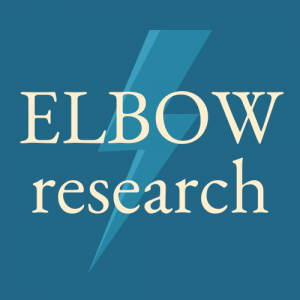Apulaisprofessori Soile Ylivuori käynnisti vuosi sitten ELBOW-tutkimusprojektinsa, jolle myönnettiin viiden vuoden iso ERC-rahoitus. Tutkimusprojektissa ovat työskennelleet viime vuodesta alkaen Ylivuoren lisäksi väitöstutkija Edna Huotari sekä tutkimuskoordinaattori Lotta Vuorio. Tämän vuoden syyskuun alussa tutkimusprojektiin liittyi mukaan vielä kaksi tutkijaa, postdoc-tutkija Annika Raapke sekä yliopistotutkija Stefan Schröder. Nyt ELBOW-tutkimusryhmä on kokonaisuudessaan valmiina tutkimaan sähkön, lääketieteen, tiedon ja kokemuksen historiaa.
Lue alta, mistä ELBOW-tutkimusprojektissa on kyse!

Mitä tarkoittaa ELBOW?
ELBOW tulee englanninkielisistä sanoista Medical Electricity, Embodied Experiences, and Knowledge Construction ja näiden sanojen kirjaimista. Nämä ovat tutkimusprojektin avainsanat, jotka johdattavat projektin tarkempien tutkimusaiheiden äärelle.
Näin ollen ELBOW-tutkimusprojektissa syvennytään siihen, miten ihmiset olivat vuorovaikutuksessa sähkön kanssa erityisesti lääketieteen historian kontekstissa. ELBOW-tutkimusprojekti on kiinnostunut siitä, miten ihmiset kokivat sähkön kehollisesti sekä miten ihmiset ymmärsivät sähkön toimintaa sekä tuottivat tietoa siitä kokemuksiinsa perusteella.
Ajallisesti historiallinen tutkimusprojekti kattaa noin vuodet 1740–1840, ja alueellisesti tutkimus keskittyy Eurooppaan ja attlanttisiin alueisiin.
Mitä ELBOW-tutkimusprojekti tekee?
ELBOW-tutkimusprojekti lähestyy sähkön kautta laajempaa ymmärrystä siitä, miten tieteellinen tieto rakentui 1700- ja 1800-luvuilla. Tieteellisen tiedon rakentumisessa keskitytään erityisesti siihen, mikä rooli kehollisuudella ja kehollisilla kokemuksilla oli tiedon rakentamisessa.
Ketkä kuuluvat ELBOW-tutkimusryhmään?

ELBOW-tutkimusryhmän jäsenet: projektijohtaja Soile Ylivuori (vas.), väitöstutkija Edna Huotari, postdoc-tutkija Annika Raapke, yliopistotutkija Stefan Schröder, ja tutkimuskoordinaattori Lotta Vuorio.
ELBOW-tutkimusprojektin työryhmää johtaa apulaisprofessori Soile Ylivuori, ja hänen rinnallaan työskentelee kolme tutkijaa: postdoc-tutkija Annika Raapke, yliopistotutkija Stefan Schröder sekä väitöstutkija Edna Huotari. Jokainen työryhmän tutkija toteuttaa omaa tutkimustaan eri ajoista ja paikoista siten, että yhteisenä tekijänä toimivat projektin keskeiset teemat sähkön ja sen kokemushistorian ympärillä.
Tutkijoiden lisäksi työryhmässä työskentelee tutkimuskoordinaattori Lotta Vuorio.
Mikä on tutkimusprojektin rahoitus?
ELBOW-tutkimusprojekti sai vuonna 2022 upean viiden vuoden rahoituksen ERC-rahoituksen Euroopan Unionilta. ERC tulee sanoista European Research Council, ja myönnetyn ERC Starting Grant tarkoituksena on tukea lupaavien tutkimusjohtajien työtä heidän tutkijan uransa alkuvaiheessa. Rahoitus kattaa vuodet 2022–2027.
Mistä ELBOW-tutkimusprojektia voi seurata?
Voit seurata ELBOW-tutkimusprojektin etenemistä, tutkijoiden arkea ja tutkimustuloksia sosiaalisen median (Facebook ja Instagram) sekä tutkimusprojektin nettisivujen ja blogin kautta.
Lue lisää projektista Helsingin yliopiston uutisesta: https://www.helsinki.fi/fi/uutiset/kulttuuri/tieteellisen-tiedon-rakentumisen-tutkimiseen-viisivuotinen-erc-rahoitus

